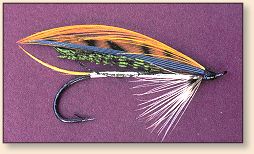Great Canadian Flies
Bounder

By Arthur James Lingren
From Fly Patterns of British Columbia, Published
by Frank Amato Publications.
We appreciate use permission.
The 1930s when Tom Brayshaw fished the Little and Adams rivers
regularly, he often used the standard-of-the-day patterns such
as Jock Scott, Mallard & Silver, Teal & Red, and Bucktail & Silver.
His thoughts, however, turned to producing more representative
imitations, in both size and colouration, of the migrating sockeye
salmon fry which made the Little and Adams rivers' large rainbow
trout fly fishing world renowned.
On 10 June 1933, Brayshaw decided to fish Little River with
Hugh Mackie. They left Vernon in the early afternoon, arriving
on the Little River's fishing grounds about 4 p.m. For the first
couple of hours they had no rises, than the fish started taking and
Brayshaw says that "we got fish at regular intervals for an hour,
he [Mackie] had another of 1 pound 9 ounches and I had four [of]
1 pound 13 ounches, 1 pound 13 ounces, and 14 ounces and 2 pounds
4 ounces." All of Brayshaw's fish were taken on a streamer-type
pattern that he detailed with a drawing and notes in his diary.
After landing his first fish of the day, one of 1 pound 9 ounces, and
referring to his previous day's catch with his fly, he gave the
fly its name and called it "The Bounder." He also commented that
he thought that "a variation with Jungle Cock sides might be good."
Brayshaw fished the Little and Adams rivers for nearly two decades
and continually altered his patterns to make them better fish
catchers. The Bounder and his Golden Pheasant & Silver are the
forerunners of Brayshaw's Little River No. 2.
Details
Hook: Number 2 low-water salmon.
Tail: A golden pheasant crest feather.
Body: Flat, silver tinsel.
Throat: A badger, cock, neck, hackle feather.
Wing: A few fronds from a peacock's sword feather followed
with strips from a golden pheasants center tail feather and strips of blue
macaw tail feather and a topping of golden pheasant crest feather.
Originator: Tom Brayshaw.
Intended Use: Wet fly for rainbow trout.
Location: Adams and Little Rivers.
~ Arthur James Lingren
Credits: From Fly Patterns of British Columbia
by Arthur James Lingren. We thank
Frank Amato Publications, Inc. for use permission!
Our Man In Canada Archives
|

